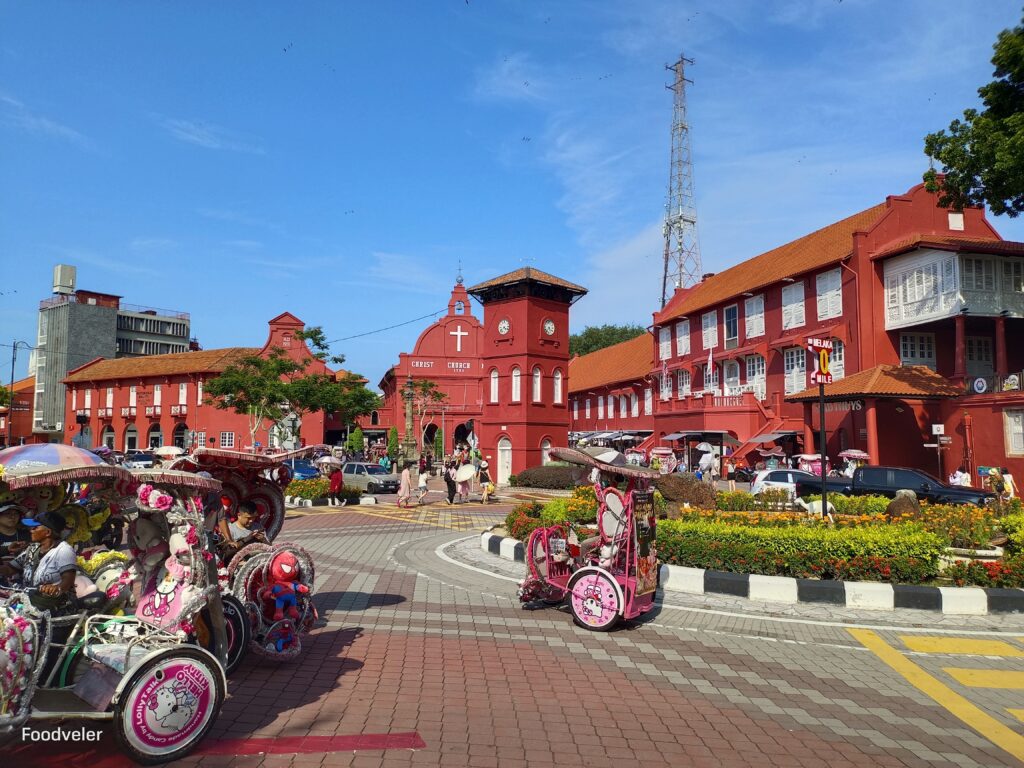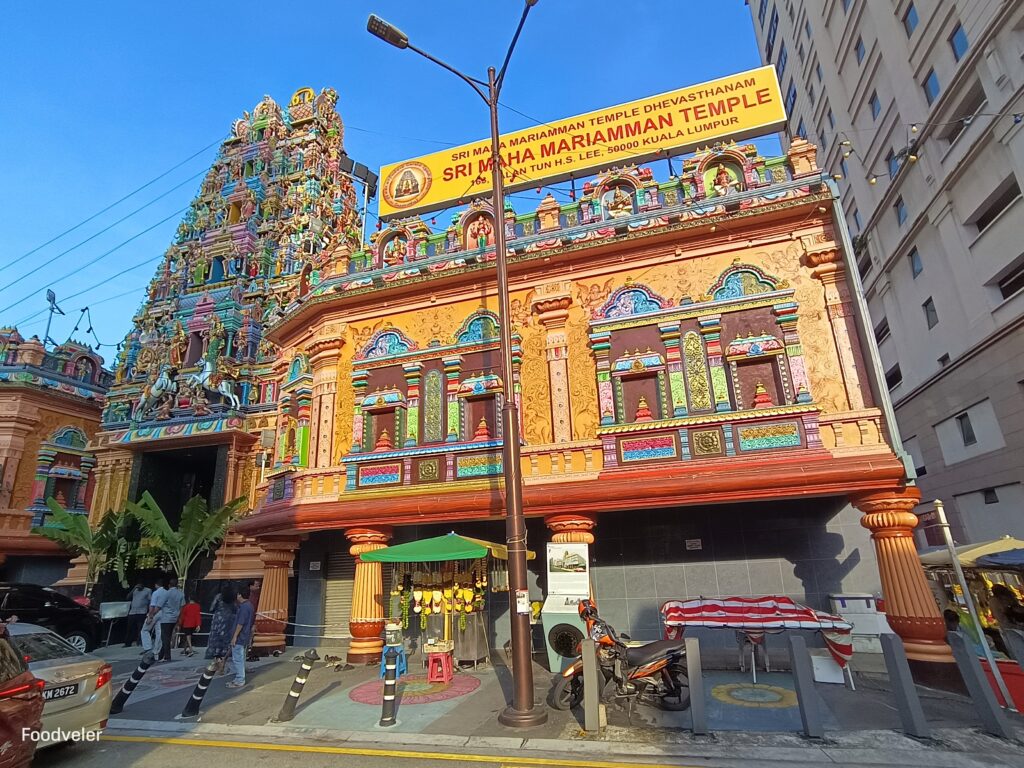Special thanks to Gohkaki Childhood Museum for extending this attraction invitation.
Update: This business has ceased its operations.
Formerly a namesake café, Gohkaki (五脚基) has been converted to a museum. This new attraction at Bishop Street (Lebuh Bishop) is called Gohkaki Childhood Museum (五脚基童玩馆).
As the name implies, this museum is dedicated to the revival of traditional toys and games from the yesteryears. Many of these once-upon-a-time popular pastime pleasures have been eclipsed in today’s modern world of video games, movies and Internet.
The museum operator believes that many of these toys and games are worth preserving, not only on nostalgic grounds, but also in virtue of the fact that they provide crucial elements in the development of a child’s mind. More often than not, these toys and games allow the child to interact with other children, therefore contributing to social skills that are lacking among youngsters in this “technological” world today.
An air well in the middle of the museum allows sunlight and natural breeze to permeate the interior of the building. This is how buildings are designed back in the old days before the introduction of electrical lighting and fans.
The calming sound of flowing water provides a sense of tranquility, much like a Zen garden. With classical melody on the background, the serene ambience invokes memory of worry-free childhood that has been forgotten in the passage of time.
Bishop Street was formerly known as “Painted Wood Street” (漆木街) because it was once a popular spot for woodwork artisans. To reflect this historical significance, the wall at the air well has been meticulously painted with detailed motif of a tree. When it rains, the sight of raindrops dripping across the surface gives an illusion of dancing leaves in the wind.
Remember our childhood obsession with Siamese fighting fish (半月斗鱼)? Pitting one’s prized fighter against another used to be a popular pastime among villagers. Although people seldom do so nowadays, this colorful fish still serves an ornamental role.
Most of us had a plush toy or toy car back during our childhood. It is amazing that such simple toys kept us captivated for much longer period than modern gadgets. Just imagine how regularly you change your mobile phone and toss the previous one away. You don’t discard your old teddy bear just like that, do you?
Rocking horse (木马), which also serves as the museum’s logo, is another beloved toy back in the good old days. Crafting rocking horse is an integral part of cottage industry in rural villages.
From time to time, the museum conducts toy-crafting workshops that are specially targeted for children. For example during the recent Mid-Autumn Festival (中秋节), children are taught how to make lanterns.
During rainy days, indoor games are never in shortage of choices. International Chess (国际象棋) is commonly played across ethnic boundaries. Using the same checkerboard, the game of Checkers or Draughts (西洋跳棋) is preferred among younger children.
Chinese Checkers (中国跳棋) is a more “peaceful” version of Checkers; no pieces are captured during “jumps”. The objective of this game is to move one’s own pieces to the opposite side of the board.
There is a Checkers puzzle which uses a specially-crafted wooden board. The object of this puzzle is to move all but one marbles to any of the larger slots at the corners. Only jumps are allowed. Each jump is made over one marble, and can be in the horizontal, vertical or diagonal direction. Can you solve this puzzle? The first person with the correct solution wins the board!
Go (围棋) is one of the most abstract board games ever conceived. The game is so complex and elusive that even computers are vastly outclassed by experienced players. Do you know that the number of possible Go games exceeds the number of atoms in the universe (1080)? It is fascinating that a human mind can still beat a computer in these astronomically large number of games!
A unique characteristic of Chinese Chess (中国象棋) is the presence of a “river” which affects the movement of certain pieces. The river is often marked with the phrase “Chu River, Han Realm” (楚河汉界), in reference to the Chu-Han Contention (楚汉相争) between 206 BCE and 202 BCE.
Double Chess (四狂象棋) is similar to Chinese Chess. The game is played by two teams of two players. Two Chinese Chess games are played simultaneously. If a player captures an enemy piece on one board, the piece can be deployed by the teammate on the other board. The game proceeds until a general on either board is captured.
There is another a creative game which combines the ranking concept of Animal Chess (门兽棋) with the guessing element of Battleship (海战棋). With a wooden plank raised between the glass panels, each player arranges his pieces on the board. When the plank is removed, pieces that coincide “fight” with each other, and defeated pieces are removed. The game is repeated until one player loses all pieces on his board.
Congkak is a traditional Malay game which uses a wooden board in the shape of a vessel. There are two rows of seven pits along its length (called “anak”), and a large pit at each end (called “indung”). Congkak is often considered a game for womenfolk. The name comes from the archaic Malay word “congak”, which means “mental calculation”. This is because a player who can mentally calculate several steps ahead of her opponent has an advantage.
While not exactly a game, young puppy lovers used to be obsessed with collecting red lucky seeds (相思豆), as they are synonymous to eternal love.
For more than two players, card games are popular due to the depth of mental deception involved. Examples of classical favorites in this genre are War Game, Ali Baba and Old Maid.
Monopoly (百万富翁) allows players to pit their financial shrewdness and negotiation skills against others. This game is a good platform to introduce children to the dynamics of the business world, where every person has a different agenda and strategy.
Plastic toy soldiers are often collected by schoolboys to re-enact epic battle scenes. Usually, the boy with the largest collection is often the most popular one.
With robot characters R2-D2 and C-3PO fresh in our minds since the first screening of Star Wars in 1977, it is every kid’s dream to have his own personal robot.
As for vehicles, popular collectibles are cars, trucks, tanks and airplanes. The museum has a larger collection of miniature models, but many of these are delicate and require glass casing to prevent damage. The upper floor of the museum is currently closed as there is much work to be done.
Especially on Sundays (when Bishop Street is closed to vehicular traffic), Gohkaki Childhood Museum also allows passers-by to get acquainted with outdoor games. Hopscotch (跳飞机), “La La Li La Tam Pong” and “One Two Tali Shom” invoke nostalgia of childhood memories. There is also a giant slingshot which is hugely popular with curious city-dwelling children.
Meanwhile, children can compete their marksmanship with a simple game of stick toss (投骠).
Jianzi (毽子) is a traditional Chinese toy made from a weighted shuttlecock with colorful feathers. The objective of the game is to keep it in the air for as long as possible without using hands. Jianzi can be played competitively between two teams, similar to volleyball and sepak takraw.
The museum also has a gift shop with different types of handcrafted toys for sale. These items are ideal as souvenirs, gifts or part of one’s collectibles.
While a small number of toys are imported, most of them are sourced locally especially from the cottage industry.
It has been a long time since I last saw a toy vending machine. This coin-operated machine is fully mechanical; no electricity is required. Each toy is delivered in an egg-like capsule, which is dispensed in a chute when the knob is turned.
Before the advent of 7-Eleven stores, there are many sundry shops that sell different kinds of “junk food”. Typically, snacks are displayed in transparent plastic containers, which in turn, are arranged on wooden racks and benches.
It is very difficult to source many of these snacks nowadays. I was surprised to see several types of goodies that I used to enjoy when I was young. It is warming to know that they are not totally “extinct”… yet.
Apart from the neighborhood sundry shops, individual peddlers used to sell these comfort food from house to house on bicycles. Some of these peddlers even innovated the “spin the wheel” gimmick to entice children to get a chance to win something extra.
Gohkaki Childhood Museum is open for slightly over a month, therefore many of its exhibits are still in the making. Admission to the museum is free for now, but the situation may change once its full collection is ready for the public. As one of the last vestiges of traditional toys and games, I urge that you pay a visit to Gohkaki Childhood Museum whenever you visit the George Town’s heritage district.
Name: Gohkaki Childhood Museum (五脚基童玩馆)
Address: 34, Lebuh Bishop, 10200 George Town, Pulau Pinang
Contact: 04-262-9916
Business hours: 9:00am-6:00pm
Website: http://www.gohkaki.com
Coordinates: 5.41859 N, 100.34179 E
Directions: Driving along the one-way Bishop Street (Lebuh Bishop), look out for Sentral Tower (Menara Sentral), Sun Wui Wui Koon (新会会馆) and Route 9 on the left. Gohkaki Childhood Museum is located next to Route 9. Street parking is available along Bishop Street and nearby roads. There is also a multi-level parking garage at Union Street (Lebuh Union). On Sunday mornings, many roads including Bishop Street are closed to vehicular traffic. During this time, the nearest street parking is located along Penang Street (Lebuh Penang).



